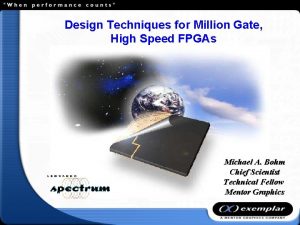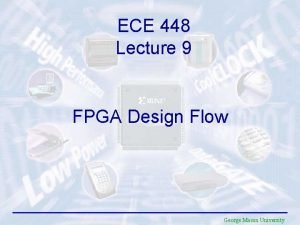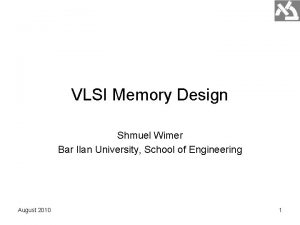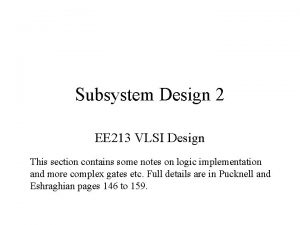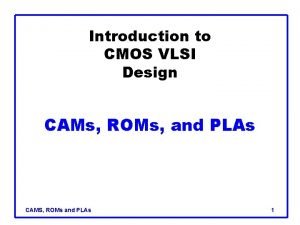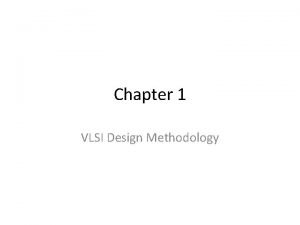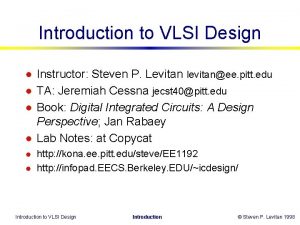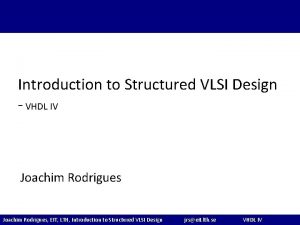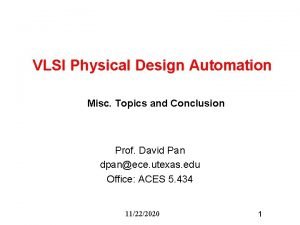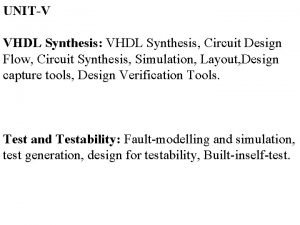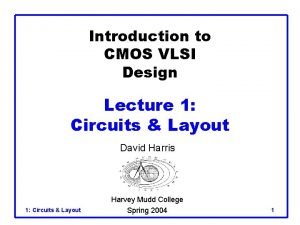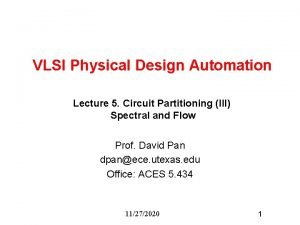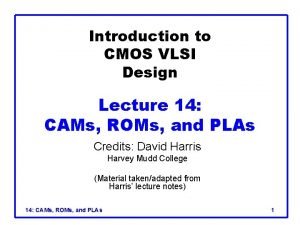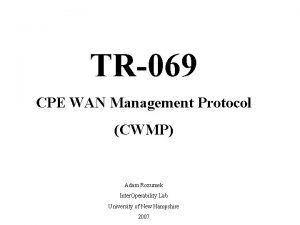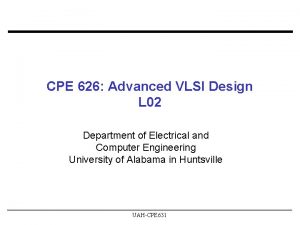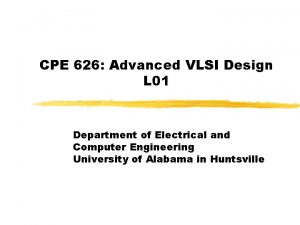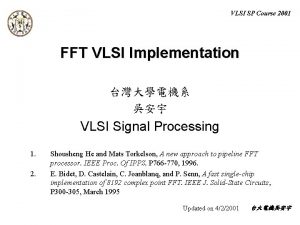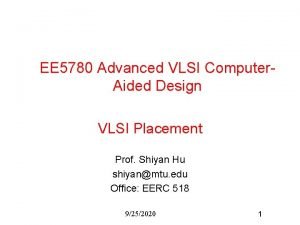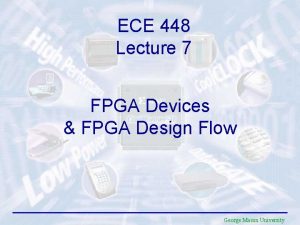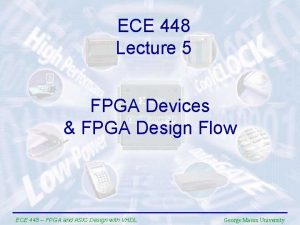CPE 626 Advanced VLSI Design Lecture 10 FPGA


































- Slides: 34

CPE 626 Advanced VLSI Design Lecture 10: FPGA Structures Aleksandar Milenkovic http: //www. ece. uah. edu/~milenka/cpe 626 -04 F/ milenka@ece. uah. edu Assistant Professor Electrical and Computer Engineering Dept. University of Alabama in Huntsville

Advanced VLSI Design Outline Programmable ASICs Introduction Antifuse Static RAM EPROM, EEPROM Technology A. Milenkovic 2

Advanced VLSI Design Introduction Programmable ASICs PLDs – Programmable Logic Devices • started as small devices (to replace a handful of TTLs) FPGAs – Field Programmable Gate Arrays FPGA – a chip you can program yourself an IC foundry produces FPGAs with some connections missing after design and simulation, special software is used to produce a string of bits describing the extra connections required to make the design – the configuration file program the chip – make the necessary connections according to the configuration file A. Milenkovic 3

Advanced VLSI Design Introduction (cont’d) No customization of any mask level FPGA are manufactured as standard part in high volumes Ideal for prototyping or for low-volume production FPGA vendors do not need IC fabrication facility Contract IC foundries to produce their parts • fabs cost hundreds of millions of dollars Put their effort in architecture and software • much easier to make a profit by selling design software A. Milenkovic 4

Advanced VLSI Design FPGA Characteristics All have regular array of basic logic cells that are configured using a programming tech. Chip inputs and outputs use special I/O logic cells A programmable interconnect scheme forms the wiring between the two types of logic cells Designers use custom software, tailored for each programming technology and FPGA architecture to design and implement interconnections Types of programming technology permanent programming (OTP – One Time Programmable) Reprogrammable or erasable A. Milenkovic 5

Advanced VLSI Design FPGA Internal Structure Top FPGA vendors in 2002 are Xilinx, Inc. and Altera Corporation Basic internal structure PLB – Programmable Logic Blocks PI – Programmable Interconnect Current trends: include RAM and/or a fixed microprocessor core A. Milenkovic 6

Advanced VLSI Design Antifuse normally it is an open circuit until forcing a programming current through it Actel calls its antifuse a programmable low-impedance circuit element (PLICE) OTP technology A. Milenkovic 7

Advanced VLSI Design Antifuse (cont’d) Programming current controls the antifuse resistance (typically for 5 m. A it is 500 Ohms) reduce resistance by increasing the current Design Steps design entry + simulation until the design is correct plug the chip into a socket on a special programming box, called Activator (provides programming voltage) PC downloads the configuration file instruction the Activator which antifuses to blow Remove the chip from the Activator In-system programming (ISP) – possibility to program the chip after it has been assembled on the PCB A. Milenkovic 8

Advanced VLSI Design Antifuse (cont’d) Actel antifuse technology uses modified CMOS process double metal, single poly typically includes 12 masks Actel process requires an additional 3 masks Actel A 1010 – 112, 000 antifuses, Actel A 1020 – 186, 000 antifuses, . . . Programming time: 5 – 10 minutes A. Milenkovic 9

Advanced VLSI Design Metal-metal antifuse Quick. Logic metal-metal antifuse connections are direct to metal wiring layers • connections from poly-diffusion antifuse to wiring layers require extra space and create additional parasitics easier to use larger programming currents to reduce the antifuse resistance A. Milenkovic 10

Advanced VLSI Design Static RAM Programming Xilinx SRAM configuration cell outputs Q and Q’ are connected to the gates of pass transistors or transmission gates cell is programmed using the WRITE and DATA lines A. Milenkovic 11

Advanced VLSI Design Static RAM Programming (cont’d) Advantages reuse chip during prototyping use ISP possibility of upgrades reconfigurable systems – change the system on the fly Disadvantage keep the power supplied to the FPGA for SRAM to retain the connection information alternatively, load the configuration from the permanently programmed memory (PROM) every time the system is turned on increased area: SRAM + switches driven by SRAM cells A. Milenkovic 12

Advanced VLSI Design EPROM Technology EPROM - Electrically Programmable Read-only Memory EPROM programmable, UV-erasable E. g. , Altera MAX 5000 EPLDs and Xilinx EPLDs a) With a high (> 12 V) programming voltage, V PP , applied to the drain, electrons gain enough energy to “jump” onto the floating gate (gate 1). (b) Electrons stuck on gate 1 raise threshold voltage so that the transistor is always off for normal operating voltages. (c) Ultraviolet light provides enough energy for the electrons stuck on gate 1 to “jump” back to the bulk, allowing the transistor to operate normally. A. Milenkovic 13

Advanced VLSI Design EEPROM Technology EEPROM – Electrically Erasable Programmable Read-only Memory Electrically programmable, UV-erasable Electric field is used to remove electrons form the floating gate Advantages faster than using a UV lamp chips do not have to be removed from the system if the system contains circuits to generate both program and erase voltages, it may use ISP A. Milenkovic 14

Advanced VLSI Design Specifications FPGA manufacturers are continually improving their products in order to increase performance and reduce price Eg. Actel ACT 1 A 1010/A 1020 – used 2 um process Actel ACT 1 A 1010 A/A 1020 A – used 1. 2 um process Actel ACT 1 A 1020 B – used 1. 0 um process, die revision Parts with identical part numbers can have different performance when different foundries produce the same parts A. Milenkovic 15

Advanced VLSI Design PREP Benchmarks Programmable Electronics Performance Company http: //www. prep. org non-profit organization that developed a series of benchmarks for FPGAs PREP 1. 3 1. An 8 -bit datapath consisting of 4: 1 MUX, register, and shift-register 2. An 8 -bit timer–counter consisting of two registers, a 4: 1 MUX, a counter and a comparator 3. A small state machine (8 states, 8 inputs, and 8 outputs) 4. A larger state machine (16 states, 8 inputs, and 8 outputs) 5. An ALU consisting of a 4 ¥ 4 multiplier, an 8 -bit adder, and an 8 -bit register 6. A 16 -bit accumulator 7. A 16 -bit counter with synchronous load and enable 8. A 16 -bit prescaled counter with load and enable 9. A 16 -bit address decoder A. Milenkovic 16

Advanced VLSI Design FPGA Economics FPGA vendors offer a wide variety of packing, speed, and qualification (military, industrial, or commercial) options in each family Xilinx part-naming convention A. Milenkovic 17

Advanced VLSI Design FPGA Pricing Xilinx XC 3000 series options from 1992 Five different size parts: XC 30{20, 30, 42, 64, 90} Three different speed grades or bins: {50, 70, 100} Ten different packages: {PC 68, PC 84, PG 84, PQ 100, CQ 100, PP 132, PG 132, CQ 184, PP 175, PG 175} Four application ranges or qualification types: {C, I, M, B} 1992 base Xilinx XC 3000 FPGA prices XC 3020 -50 PC 68 C $26. 00 XC 3030 -50 PC 44 C $34. 20 XC 3042 -50 PC 84 C $52. 00 XC 3064 -50 PC 84 C $87. 00 XC 3090 -50 PC 84 C $133. 30 A. Milenkovic 18

Advanced VLSI Design Summary FPGA programming technologies antifuse SRAM EPROM technologies Key elements The programming technology The basic logic cells The I/O logic cells Programmable interconnect Software to design and program the FPGA A. Milenkovic 19

Advanced VLSI Design Advanced FPGAs Xilinx XC 9500 Xilinx Virtex-II Altera Stratix A. Milenkovic 20

Advanced VLSI Design Xilinx XC 9500 Selected features High-performance • 5 ns pin-to-pin logic delays on all pins Large density range - 36 to 288 macrocells with 800 to 6, 400 usable gates 5 V in-system programmable Endurance of 10, 000 program/erase cycles Program/erase over full commercial voltage and temperature range Programmable power reduction mode in each macrocell High-drive 24 m. A outputs 3. 3 V or 5 V I/O capability Advanced CMOS 5 V Fast. FLASH technology Supports parallel programming of multiple XC 9500 devices A. Milenkovic 21

Advanced VLSI Design Xilinx XC 9500 A. Milenkovic 22

Advanced VLSI Design Xilinx XC 9500 Function Block A. Milenkovic 23

Advanced VLSI Design Xilinx XC 9500 Macrocell A. Milenkovic 24

Advanced VLSI Design Xilinx XC 9500 Macrocell Clock Set/Reset Cap. A. Milenkovic 25

Advanced VLSI Design Product Term Allocator A. Milenkovic 26

Advanced VLSI Design Product Term Allocator A. Milenkovic 27

Advanced VLSI Design Fast. CONNECT Switch Matrix A. Milenkovic 28

Advanced VLSI Design IO Block A. Milenkovic 29

Advanced VLSI Design Xilinx Virtex-II Selected features 40 K – 8 M gates 420 MHz internal clock speed 840 Mb/s IO data Arithmetic functions • dedicated 18 x 18 multipliers • fast look-ahead carry chains Flexible logic resources • • up to 93, 184 registers/latches with Clock Enable up to 93, 184 LUTs or cascadable 16 -bit registers wide Muxes internal 3 -state bussing . . . A. Milenkovic 30

Advanced VLSI Design Xilinx Virtex-II (cont’d) Configurable Logic Blocks (CLBs) provide functional elements for combinatorial and synchronous logic, including basic storage elements. BUFTs (3 -state buffers) associated with each CLB element drive dedicated segmentable horizontal routing resources. Block Select. RAM memory modules provide large 18 Kbit storage elements of True Dual-Port RAM. Multiplier blocks are 18 -bit x 18 -bit dedicated multipliers. DCM (Digital Clock Manager) blocks provide selfcalibrating, fully digital solutions for clock distribution delay compensation, clock multiplication and division, coarse and fine-grained clock phase shifting. A. Milenkovic 31

Advanced VLSI Design Xilinx Virtex-II (cont’d) A. Milenkovic 32

Advanced VLSI Design Altera Stratix PLD (cont’d) New high-performance architecture built for block-based design methodology Based on an industry-leading 1. 5 -V, 0. 13 -µm, all-layer-copper process System-Level Features Up to 114, 140 logic elements (LEs) Up to 10 Mbits embedded memory and 12 terabits per second memory bandwidth Up to 28 optimized digital signal processing (DSP) blocks Up to 116 high-speed differential I/O channels with up to 80 channels optimized for 840 -Mbps operation Up to 12 phase-locked loops (PLLs) supporting 40 different clock domains On-chip termination for differential and single-ended I/O standards that improves signal integrity and simplifies board layout Convenient remote system upgrade capability and configuration error recovery circuitry A. Milenkovic 33

Advanced VLSI Design Altera Stratix PLD A. Milenkovic 34
 Cmos vlsi design lecture notes
Cmos vlsi design lecture notes Ssa1699
Ssa1699 Cs 626
Cs 626 Ab 626 san bernardino county
Ab 626 san bernardino county Rischi fisici microclima e illuminazione
Rischi fisici microclima e illuminazione 01:640:244 lecture notes - lecture 15: plat, idah, farad
01:640:244 lecture notes - lecture 15: plat, idah, farad High speed design techniques
High speed design techniques Fpga design flow
Fpga design flow Fpga design flow
Fpga design flow Fpga design
Fpga design Fpga design methodology
Fpga design methodology Advanced inorganic chemistry lecture notes
Advanced inorganic chemistry lecture notes Memory design in vlsi
Memory design in vlsi Y chart in vlsi design
Y chart in vlsi design Vlsi design tutorial
Vlsi design tutorial Subsystem design in vlsi
Subsystem design in vlsi Mixed signal vlsi design
Mixed signal vlsi design Vlsi
Vlsi Vlsi design tutorial
Vlsi design tutorial Y chart vlsi
Y chart vlsi Cmos layout design
Cmos layout design Y chart in vlsi design
Y chart in vlsi design Ad hoc testable design techniques in vlsi
Ad hoc testable design techniques in vlsi Introduction to vlsi design
Introduction to vlsi design Structured vlsi design
Structured vlsi design Vlsi conclusion
Vlsi conclusion Vlsi design styles
Vlsi design styles Vhdl design flow
Vhdl design flow Vlsi design flow
Vlsi design flow Conduction complement rule
Conduction complement rule åq
åq Rom design in vlsi
Rom design in vlsi Tr 069 cpe wan management protocol
Tr 069 cpe wan management protocol Tr069 means
Tr069 means Portal único docente neuquén
Portal único docente neuquén






